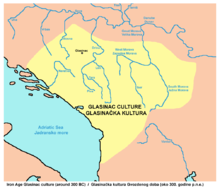
Back Qədim İlliriya mədəniyyəti Azerbaijani Ilirska kultura BS Հին Իլլիրիայի մշակույթ Armenian Ежелгі Иллирия мәдениеті Kazakh Senās Ilīrijas kultūra Latvian/Lettish Kultura ilire Albanian Antik İlirya kültürü Turkish


The Culture of ancient Illyria or Illyrian culture begins to be distinguished by increasingly clear features during the Middle Bronze Age and especially at the end of the Late Bronze Age. Ceramics as a typical element is characterized by the extensive use of shapes with two handles protruding from the edge as well as decoration with geometric motifs. At this time the first fortified settlements were established. The local metallurgy produced various types of weapons on the basis of Aegean prototypes with an elaboration of artistic forms. The main tools were the axes of the local types "Dalmato-Albanian" and "Shkodran", as well as the southern type of double ax. Spiritual culture is also expressed by a burial rite with mounds (tumuli) in which a rich material of archaeological artifacts has been found.[1][2][3][4]
- ^ Lafe, Emil, ed. (2008). "Fjalor Enciklopedik Shqiptar". (Encyclopedic Dictionary of Albania) (in Albanian). Vol. 2. Tiranë: Akademia e Shkencave e Shqipërisë. pp. 977–978. ISBN 9789995610272. OCLC 426069353.
- ^ Ceka, Neritan (2005), The Illyrians to the Albanians, Publ. House Migjeni, ISBN 99943-672-2-6
- ^ Jaupaj, Lavdosh (2019). Etudes des interactions culturelles en aire Illyro-épirote du VII au III siècle av. J.-C (Thesis). Université de Lyon; Instituti i Arkeologjisë (Albanie).
- ^ Kurti, Rovena (2017). "On some aspects of the Late Bronze Age burial costume from north Albania". Proceedings of the International Conference "New Archaeological Discoveries in the Albanian Regions" 30-31, January, Tirana 2017.
© MMXXIII Rich X Search. We shall prevail. All rights reserved. Rich X Search